|
Paper 6
The Works of Thomas Wilson, Dancing Master
Contributed by Paul Cooper, Research Editor
[Published - 6th August 2014, Last Changed - 14th March 2025]
In previous papers we've discussed the life of Thomas Wilson and his Quadrilles. In this article we'll review his many works on dancing. I've been maintaining a collection of links for each Wilsonian work that I can find, I thought this information might be of interest to the wider Historical Dance community. This collection is presented in tabular form and will be updated as new information becomes available. A significant proportion of the works are not available on-line but I've provided links to copies where available. If you have any further information to add, or an original document to share, please do get in touch.
I've not attempted to provide dates to greater accuracy than one year. Where a document claims to have been published in a particular year, I've believed it. Where it claims to be published for a year, I've credited it to that same year (though it could have been published towards the end of the previous year). In most cases we can date the works by external references in dated publications (magazines, newspapers, etc.) but some dates remain obscure. I've provided links to independent dating information where available.
It's likely that further Wilsonian works have existed. This list is as complete as I've been able to make it, I'd welcome any new information that can improve it further. If you can help then please do get in touch. Some of these works are (as far as I know) lost, others are only available through private collections or national libraries. The price of a work is a useful clue to the relative importance of the work: a simple country dance collection typically cost a shilling, a major work such as the Complete System of English Country Dancing cost 10 shillings and 6 pence. A work that cost 4 shillings would have had significantly more content than a work that cost 2 shillings. I've included the pricing information, where known.
Some of the documents were published in multiple editions. The content of a work can vary significantly from one edition to the next, we can't assume the content from later editions is present in earlier editions. If you have access to a different edition of one of these works, or can provide information about the edition specific changes, once again do please get in touch.
Table of Works on Dancing
| Work & Date | Image | Comments |
An Analysis of
Country Dancing
1808, 1811, 1811, 1822 |
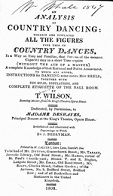
|
Wilson's 1808 Analysis of Country Dancing is a very important work. He aimed to record all of the figures used in English Country dancing at the time. He explained them using both diagrams and text, it's our primary source for understanding the Country Dancing figures of the Regency period.
The first edition (pictured) was published in 1808. According to an advert in The Monthly Magazine (May 1st 1809), the first edition was being sold for 7s. There were a thousand copies of the first edition printed.
The second edition was published in 18111. The third edition was also published in 1811, with significant new content. A 4th edition was published in 1822. Analysis was updated and republished as The Complete System of English Country Dancing, around 1816 or 1820.
The content of this work was revised in the later editions.
An early review of this work in the Stamford Mercury (30th December 1808) reads:
The admirers of this fascinating and polite amusement, who are desirous of joining their friends at the approaching assemblies, but feel deficient for want of practice, have now an opportunity of perfecting themselves by the assistance of a new work just published, which shews, by coloured plates, the plan and definition of every figure in the poetry of motion so very clearly, that even children may comprehend the instructions. - To boarding-schools it would also be a great acquisition by improving the pupils in any figure previously to the next visit of the master, thereby facilitating the accomplishment of Dancing with proficiency and dispatch, and will completely remedy the great inconvenience of delay occasioned by the distant residence of professional gentlemen usually attending schools or private families.
Full Title (1st edition): An analysis of Country Dancing: wherein are displayed all the figures ever used in Country Dances, in a way so easy and Familiar, that persons of the meanest capacity may in a short time acquire (without the aid of a master) a complete knowledge of that rational and polite amusement. To which are added, instructions for dancing some entire new Reels, together with the rules, regulations, and complete etiquette of the ball room. By T. Wilson, Dancing Master, from the King's Theatre, Opera House. Dedicated, by permission, to Madame Deshayes, Principal Dancer at the King's Theatre, Opera House. Embellished and illustrated with Engravings on Wood, by J. Berryman. Printed by W. Calvert.
The dedication in the third edition changed to Madame Angiolini, principal dancer at the King's Theatre Opera House , printed by James Gillet. The 4th edition retains the dedication to Madam Angiolini but promised coloured engravings , it was once again published through W. Calvert.
|
The Treasures
of Terpsichore
1809, 1816 |
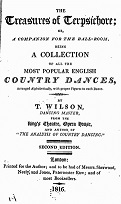
|
This work contains a large collection of suggested dancing figures for use with popular Country Dance tunes. Wilson provided two sets of figures that could be danced with each tune but no music. In each case there is an arrangement involving a single repetition of the tune; many also have a double arrangement with more complex figures where the tune is played through twice. Most of the tunes are well known from other contemporary dance collections, others were more obscure and were only available directly from Wilson.
Several supplements were subsequently published; a second edition (pictured) was published in 1816. According to the Edinburgh Annual Register for 1809, the first edition sold for 4s 6d.
James P. Cassidy in his 1810 Treatise on the Art of Dancing referred to this work in unflattering terms: ... as I have seen in a late publication of country dances called the 'Treasures of Terpsichore,' but which I think should be universally exploded, as unintelligible and useless;... 2.
Edward Payne also wrote against books like this in his 1814 A New Companion to the Ball Room. He complained that most books that taught country dancing associated specific figures with specific tunes and lamented that this frequently caused dancers to perform them in those precise combinations. He preferred to encourage any tune to be danced with any set of figures. He didn't refer to Treasures of Terpsichore by name but it's likely he was referring to it (Payne's book is named using the subtitle of this work).
We've written a little more about Wilson's Treasures of Terpsichore here.
Full Title (2nd edition): The Treasures of Terpsichore; or, a companion for the ball-room. Being a collection of all the most popular English Country Dances, arranged alphabetically, with proper figures to each dance. By T. Wilson, Dancing Master from the King's Theatre, Opera House, and author of "The Analysis of Country Dancing".
The second edition was published by Messrs. Sherwood, Neely, and Jones.
|
The Treasures
of Terpsichore
for 1810
|
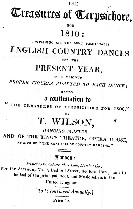
|
Google have indexed this work3. It contained choreographed figures for a further 40 tunes selected from various publications that were current for the year 1810. It cost 1s.
Full Title: The Treasures of Terpsichore for 1810: Containing All the Most Fashionable English Country Dances for the Present Year, with Various Proper Figures Adapted to Each Dance, Being a Continuation to The Treasures of Terpsichore for 1809.
It's printed by W. Calvert.
|
Supplement
to the
Treasures of
Terpsichore
1811
|
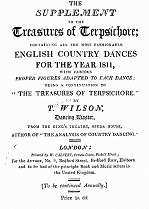
|
A copy can be found bundled within the 1816 second edition of Treasures of Terpsichore at the Library of Congress. The cover states that it is to be continued annually and costs 1s 6d.
A subtitle within the work says Supplement to the Treasures of Terpsichore for 1810 and 1811 . This hints at the possibility that the 1811 supplement includes the content from the 1810 supplement.
Full Title: The Supplement to the Treasures of Terpsichore; containing all the most fashionable English Country Dances for the year 1811, with various proper figures adapted to each dance; being a continuation to "The Treasures of Terpsichore" by T. Wilson; Dancing Master, from the King's Theatre, Opera House, author of "The Analysis of Country Dancing".
It's printed by W. Calvert.
|
Original Collection of Country Dance Music for the Year 1811
|
|
An advert in the 1811 Supplement to the Treasures of Terpsichore references this work4. It's said to be just published in a handsome Folio Sheet . It was priced at 1s 6d and contained some of Wilson's own music for dances in the Terpsichore collection for 1811.
|
All the Select New Fashionable Dances for 1812
|
|
This work is advertised within the third edition of An Analysis of Country Dancing5, priced at 1s. It may be a reference to the 1811 Supplement to Treasures of Terpsichore, or may be the subsequent annual update. |
Four New Country Dances
1812
|

|
Originally published in La Belle Assemblee magazine, new series, number 38. The music is by William Harmony. |
Button & Whitaker's Twenty Four Country Dances for the year 1812
|
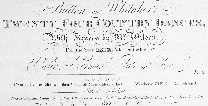
|
Purday & Button (later Button & Whitaker) had taken over the Thompsons business in 18056. They continued publishing under both the Thompson name and under their own name. This is the first dance collection they published with figures acknowledged to be by Wilson (though earlier works may have featured Wilson's figures without attribution). For a content listing see here.
Full Title: Button and Whitaker's Twenty Four Country Dances, with figures by Mr Wilson. For the year 1812, adapted for the Violin, German Flute or Oboe.
|
Thompson's Twenty Four Country Dances, for the Year 1813
|
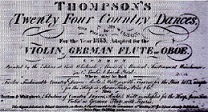
|
From 1812 Wilson began publishing three different sets of 24 annual Country Dance collections under the Thompsons, Button & Whitaker and Le Sylphe monikers. Annual country dance collections had been published by many music sellers throughout the 18th Century, Wilson's dance collections can be seen as a continuation of that trend. All three series were in fact published by Button & Whitaker. This is the first under the Thompsons name. It's likely that Wilson had little or no influence over the music for these collections, he was just invited to provide the dancing figures.
Several archives list the existence of this work and attribute the figures to Thomas Wilson. See, for example, Google7. For a content listing see here.
Full Title: Thompson's Twenty Four Country Dances, the figures by Mr. Wilson, for the year 1813. Adapted for the Violin, German Flute or Oboe.
|
Button & Whitaker's Twenty Four Country Dances for the year
1813
|
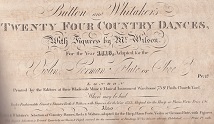
|
This is the second work in Wilson's Button & Whitaker series of Country Dance collections.
One interesting aspect of this collection is that it features country dancing figures invented by Wilson, including his double triangles . These new figures don't appear in his earlier works. He must have felt confident in his own influence to use them in a commercial dance collection. The double triangles frequently reappear in his later country dance collections. For a content listing see here.
Full Title: Button and Whitaker's Twenty Four Country Dances, with figures by Mr Wilson. For the year 1813, adapted for the Violin, German Flute or Oboe.
|
Le Sylphe. An elegant collection of twenty four country dances for the year 1813
|
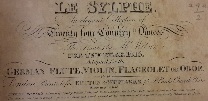
|
Wilson published an annual collection of Country Dances under the name Le Sylphe between 1813 and 1818. This collection is particularly associated with Waltz Country Dances (an adaptation of the Country Dance, distinct from a regular country dance set to music in Waltz-time, though the precise differences are unclear). The first Le Sylphe to feature these dances was the edition for 1815, this 1813 edition is a collection of ordinary Country Dances.
This work is catalogued in several places. See, for example, Amazon8. For a content listing see here.
Full Title: Le Sylphe. An Elegant Collection of Twenty Four Country Dances, the figures by Mr Wilson, for the year 1813, adapted for the German Flute, Violin, Flageolet or Oboe.
|
L'Assemblée, or Forty Eight Elegant New Dances for the year 1813
|
|
Wilson began publishing a fourth series of Country Dances from 1813 under the name L'Assemblée . This new series was on a larger format of paper and each tune featured a bass accompaniment to the treble score, it was presumably aimed at a more affluent market. The first edition for 1813 was reviewed in The Monthly Magazine, they wrote: These dances, which have single and double figures to each, by Mr Wilson, possess considerable life and animation. More variety than is usual in collections of this kind, forms one of the features of the publication, and marks the inventive fancy of the composer. .
This title was published through Button and Whitaker and cost 3s.
Full Title: L'Assemblée, or Forty Eight Elegant New Dances for the year 1813, arranged for the Piano Forte or Harp, with Single and Double Figures to each Dance by Mr Wilson.
|
No 21-29 of Button, Whitaker & Compy's Selection of Dances, Reels & Waltzes.
1813-1814
|
|
Each individual volume in this collection included around 8 Country Dancing tunes with figures choreographed by Wilson. For a content listing see here.
|
Le Sylphe. An elegant collection of twenty four country dances for the year 1814
|
 |
This is the second work in the Le Sylphe series of Country Dance collections.
This work is catalogued in several places. See, for example, Amazon9. For a content listing see here.
Full Title: Le Sylphe. An Elegant Collection of Twenty Four Country Dances, the figures by Mr Wilson, for the year 1814, adapted for the German Flute, Violin, Flageolet or Oboe.
Image © BRITISH LIBRARY BOARD, a.9.aa.(2.) ALL RIGHTS RESERVED
|
Button & Whitaker's Twenty Four Country Dances for the year 1814
|
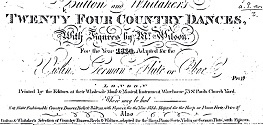 |
This is the third work in Wilson's Button & Whitaker series of Country Dance collections.
It's referenced from the British Library10. For a content listing see here.
Full Title: Button and Whitaker's Twenty Four Country Dances, with figures by Mr Wilson. For the year 1814, adapted for the Violin, German Flute or Oboe.
Image © BRITISH LIBRARY BOARD, a.9.aa.(3.) ALL RIGHTS RESERVED
|
L'Assemblée, or Forty Eight Elegant New Dances for the year 1814
|
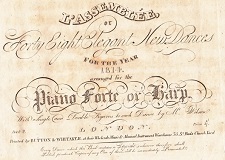
|
Wilson continued publishing his fourth series of Country Dances in 1814, this edition was described as Book 2 and the first page is numbered 25.
This title was published through Button and Whitaker and cost 3s. For a content listing see here.
Full Title: L'Assemblée, or Forty Eight Elegant New Dances for the year 1814, arranged for the Piano Forte or Harp, with Single and Double Figures to each Dance by Mr Wilson.
|
Button, Whitaker & Beadnell's Twenty Four Country Dances for the year 1815
|
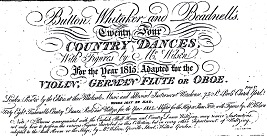 |
This is the fourth collection with Wilsonian figures published by Button & Whitaker under their own name.
This document is referenced from the British Library11. For a content listing see here.
Full Title: Button, Whitaker, and Beadnell's Twenty Four Country Dances, with figures by Mr. Wilson, for the year 1815. Adapted for the Violin, German Flute or Oboe.
Image © BRITISH LIBRARY BOARD, a.9.k.(2.) ALL RIGHTS RESERVED
|
Forty Eight Fashionable Country Dances, Reels and Waltzes, for the year 1815
|
|
This document is advertised on the cover of the previous work. This is almost certainly the next installment of Wilson's L'Assemblée series. For a content listing see here.
Full Title: Forty Eight Fashionable Country Dances, Reels and Waltzes, for the year 1815, Adapted for the Harp or Piano Forte, with Figures by Mr Wilson.
|
Le Sylphe. An elegant collection of twenty four country dances for the year 1815
|
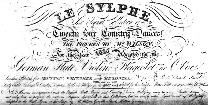
|
The third annual Le Sylphe collection of dances. This is the first in the series to feature Waltz Country Dances. Most Wilsonian country dance collections after this date feature examples of this dance form. The specific differences between a Waltz Country Dance and a regular Country Dance aren't clear but they feature such figures as Turn a-la Waltz or Pousette with Sauteuse step.
The Australian Colonial Dance site have a facsimilie of one page of this document.
|
A Technical Ball Room Dictionary
1816
|
|
This document is advertised in numerous sources in 1816. See, for example, The Gentleman's Magazine12. Several adverts indicate that it was also intended to be included as an essay within the Complete System of English Country Dancing; however, the version of that work available to me appears not to include the dictionary.
The Quadrille & Cotillion Panorama does contain a technical dictionary. That list is specific to Quadrille Dancing but may be related to this work.
|
No 30 of Button, Whitaker & Compy's Selection of Dances, Reels & Waltzes.
1816
|
|
This collection featured a Country Dance called Paddy Carey. The Morning Post for 24th January 1816 reported: Paddy Carey - The above popular Air may now be had arranged as a Country Dance by the Composer, Mr. Whitaker, with single and double Figures. Price 1s. By Mr. Wilson. . The publication itself adds As several Music-Sellers in England and Ireland, have suffered very severely from Prosecutions instituted against them for having Published piratical Copies of this Dance, it is hoped that this will operate as a sufficient caution against any other persons incurring similar penalties, by publishing, or vending, mutilated, or piratical editions of it in future . For a content listing see here.
Full Title: No 30, Button, Whitaker & Compy's Selection of Dances, Reels & Waltzes, for the Piano forte, harp, violin or German Flute, with Double & Single Figures to each Dance by Mr Wilson. Price 1s
|
No 31 of Button, Whitaker & Compy's Selection of Dances, Reels & Waltzes.
c.1816
|
|
This collection either dates to late 1816 or 1817, it consists of an unnamed Quadrille Set and the National Waltz. For a content listing see here.
Full Title: No 31, Button, Whitaker & Compy's Selection of Dances, Reels & Waltzes, for the Piano forte, harp, violin or German Flute, with Double & Single Figures to each Dance by Mr Wilson. Price 1s.
|
The Correct Method of Waltzing
1816, 1817
|
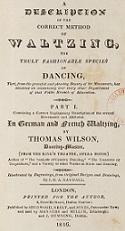
|
The Morning Post on the 11th July 1816 carried an advert that read: This day is published, price 10s.6d. in extra boards, The Correct Method of German and French Waltzing. By T. Wilson .
This was initially intended to be published in two parts, the first of which (pictured) was printed in 1816. An advert at the end of Part 1 informs us that The Second Part of 'The Description on the Correct Method of Waltzing' is now preparing for the Press . I'm not aware of any evidence that a Part 2 was published, though a second edition was published in 181713. The second edition sold for 5d 6d; an advert in the back of the Companion to the Ball Room reports that the Second Edition is a fact-simili of the first, of which only 250 was printed , it goes on to say This work is printed in an unique style by Mr. Peart, with descriptive engravings, the Ladies and Gentlemen in fashionable full dress; a sketch of the Five Positions in Dancing, and a ground sketch showing the movements formed within the Circle. .
It's possible that the originally proposed Part 2 evolved into a later work called Le Moulinet &c,. A brief review in The Gentleman's Magazine & Historical Chronicle for 1st April 1817 reports The volume is splendidly printed; and will be a curious morsel for some Bibliomaniac of the next Century .
Full Title: A Description of the Correct Method of Waltzing, the truly fashionable species of dancing, that, from the graceful and pleasing beauty of its movements, has obtained an ascendancy over every other department of that polite branch of education. Part 1. Containing a correct explanatory description of the several movements and attitudes in German and French Waltzing, by Thomas Wilson, Dancing-Master, (from the King's Theatre, Opera House) author of "The Analysis of Country Dancing," "The Treasures of Terpsichore," and a variety of other works on music and dancing.
It's illustrated by engravings, from original designs and drawings, by J. H. A. Randall and published through Sherwood, Neely and Jones.
|
A Companion to the Ball Room
1816, 1817, 1817, 1820?
|
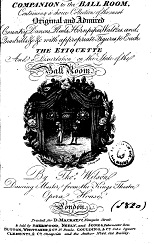
|
Wilson began work on this book as early as 1811, he references it in an advert in the third edition of An Analysis of Country Dancing14. He tells us that this work is not only intended for the Learner, but will be particularly adapted for Teachers of Dancing, and Country-Dance Musicians . It contained the music and dance instructions for a large number of dances, of many varieties. The Gentleman's Magazine in 181615 records the publication of the first edition. A second edition was published in 1817; the second edition included new material, notably a collection of Quadrilles, Sir Roger de Coverly and the Cushion Dance. A third edition was also published in 181716. A fourth edition (pictured) was published some time after 1817, perhaps 1820. The third edition sold for 10s 6d.
Full Title (4th edition): A Companion to the Ball Room, containing a choice collection of the most original and admired Country Dances, Reels, Hornpipes, Waltzes, and Quadrilles, &c &c with appropriate figures to each. The Etiquette and a dissertation on the state of the Ball Room. By Thomas Wilson, Dancing Master from the King's Theatre Opera House.
It's printed by D. Mackay.
|
The Quadrille Instructor
1817, 1817
|
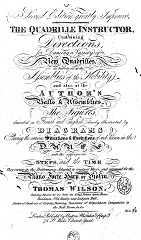
|
The first edition of the Quadrille Instructor was probably published in early 1817 (possibly late 1816 though it was reviewed as a New Musical Publication in February 1817). A significantly extended second edition (pictured) was printed in mid 181717.
Another dance master, Edward Payne also published a book called The Quadrille Instructor in 1816, some contemporary references may therefore be to Payne's publication rather than Wilson's.
An advert for the second edition was published in The Morning Post on the 29th March 1817. It reports This Edition, independently of any additional Diagrams and Instructions, contains 19 elegant Quadrilles, 15 of them received by the Publishers within these few days from Paris.
Full Title (2nd edition):
Second Edition greatly improved, The Quadrille Instructor, containing directions for dancing a variety of new Quadrilles, as introduced at the assemblies of the nobility, and also at the author's balls & assemblies. The figures described in French and English, clearly illustrated by diagrams showing the various situations & evolutions of each person in the dance, with the appropriate steps, and the time they occupy in the performance, adapted to original music, and arranged for the piano forte, harp or violin, by Thomas Wilson, Dancing Master &c &c from the King's Theatre Opera House.
It's published by Button, Whitaker & Company and costs 7s 6d.
|
Le Sylphe. An elegant collection of twenty four country dances for the year 1816
|

|
Another title in the Le Sylphe series of publications. For a content listing see here.
Full Title: Le Sylphe, an Elegant Collection of Twenty Four Country Dances, the figures by Mr. Wilson, for the year 1816. Adapted for the German Flute, Violin, Flageolet or Oboe.
|
The Valentine Waltz
1816?
|
|
This work was advertised in the 1821 The Address as costing 1s6d. It Probably contained instructions for the choreographed display waltz he introduced for his Valentines Day Balls from 1815 (though he indicated in 1816 that it was being presented for the 4th time, The Morning Post 10th February 1816). Wilson advertised that the several letters forming the word 'Valentine' will be successively displayed by the group of Ladies performing it . He would go on to describe this type of choreographed Waltzing as English Waltzing, he claimed in The Address to have invented it and first publicly demonstrated it in 1815; the routine remained in his repertoire into the mid 1830s (The Morning Post, 13th Fenruary 1836) and perhaps beyond.
|
The Guaracha Contra Dance
1816?
|
|
This work was advertised in the 1821 The Address as costing 2s. I have no information about the date of publication or the contents, it's likely to have documented the popular Spanish Country Dance of the same name.
|
La Batteuse
1817
|

|
The Gentleman's Magazine provides an extensive review of this work in 181718. La Batteuse was a French Country Dance that every teacher of fashionable dancing should become properly acquainted with . The Repository of Arts suggests that this work was effectively a sequel to The Quadrille Instructor, it documents the Batteuse in detail, with diagrams. The tune is unusual, it consists of 10 bars in each strain rather than the more common 819, the figures emphasise complex solo footwork.
The La Batteuse quadrille is included in a list of New Quadrilles sold by Willis in Dublin in 1818 (Freeman's Journal, Dublin, May 27, 1818) and in a list of New French Quadrilles taught by Mrs. West in New York in 1817 (New-York Evening Post, Sept 17, 1817). Another London based dance master, Louis Jansen, published music for this dance around 1815; he described it as a French Figure Dance . The great Scottish band leader Nathaniel Gow printed 10 bars of La Batteuse music as part of his 6 Favorite Dances of 1815. Wilson also featured this dance in his 73rd public Ball, in 1817.
We're written more extensively on La Batteuse elsewhere.
Full Title: The celebrated and fashionable dance La Batteuse, with the various figures correctly explained, as danced at Paris, and at all the fashionable balls and assemblies of the nobility and gentry, and also at the author's balls and assemblies: clearly illustrated by diagrams, showing the various movements of which it is composed. Arranged for the pianoforte, or violin, by Thomas Wilson, Dancing-Master; from the King's Theatre Opera House.
It was published by Button & Whitaker and cost 3s.
Image © BRITISH LIBRARY BOARD, h.125.(34.) ALL RIGHTS RESERVED
|
Le Moulinet, the Allemande and the Waltz Quadrilles
1817
|
|
The New Monthly Magazine reviewed this work in 1817. It is said to have included an image of Wilson and one of his pupils dancing a Waltz Minuet20. An 1817 advert in The Repository of Arts refers to it by a different name: The Allemand, Le Moulinet, and The Waltz Quadrilles 21. A few months later they reported the title to be The Allemand, Le Piraulte, Le Moulinet, and The Waltz Quadrilles, with the Waltz Minuet 22.
La Belle Assemblée's review is particularly effusive23, they report We may almost venture to affirm that no one has brought the Waltz to such perfection in this country as Mr. Wilson . They go on to say We earnestly recommend this publication to our fair readers as an almost indispensable companion to the ball-room, especially to those that are partial to the Waltz .
It's possible that this work is the second volume of Wilson's Correct Method of Waltzing, published under a different name; it appears to describe the fusion of waltzing with other dance forms. A footnote in A Companion to the Ball Room mentions that Wilson was working on a treatise on Waltz Country Dancing, potentially a reference to what became this work.
It cost 4s and was published through Button, Whitaker & Co.
|
L'Etoile Cotillion
1817
|
|
The Repository of Arts mentions this work in their advert for Le Moulinet, &c.24. It was said to be explained by diagrams and cost 1s6d. It was published through Button, Whitaker & Co.
The Quadrille Instructor includes a Quadrille called L'Etoile , so this work may contain a variation of that Quadrille, adapted to a Cotillion. Wilson also included a L'Etoile figure in his Quadrille and Cotillion Panorama.
|
The Favourite Spanish Contra Dance
1817
|
|
The Repository of Arts also mentions this work in their advert for Le Moulinet, &c.22. It was also said to be explained by diagrams and cost 1s. It was also published through Button, Whitaker & Co.
The Spanish Contra Dance is likely to be the Country Dancing variation in which the first couple start improper (the man on the ladies side of the set). This is also the main characteristic of the Ecossoise, so this work may be related to The Ecossoise Instructor.
Spanish Country Dancing first appeared in England around 1816 and was pioneered by a dancing master named Edward Payne. We've written more about them elsewhere. It's possible (though unlikely) that Payne invented the format, it's more probable that they returned from Spain with the troops from the Peninsula Wars. They're better known from the writings of G.M.S. Chivers, especially his 1819 Recueil des Dances Espagnoles, or Spanish Country Dancing made plain and easy. Wilson's contribution is unlikely to be significant, given that it only cost 1 shilling.
|
Payne's & Wilson's Quadrille Figures in French and English
1817
|
|
This collection of miniature dance cards was reviewed in The Repository of Arts in 181724. The cards cost 3s and were published through Button, Whitaker and Company. A separate collection of cards containing the associated music were also available for 6s.
The New Monthly Magazine also reviewed these cards in 181725, they refer to it as Paine's and Wilson's Quadrille Figures in French and English. There may have been two different collections, one with Edward Payne and one with James Paine, though I suspect a mistake in one of the sources. The New Monthly Magazine comment that Their merits are various; the best tunes are L'Ete, Robinet and Mariette, Le Phantome, La Paysanne.
Publication of sets of Quadrilles as miniature cards was common in the late 1810s. The cards generally measure an inch by two inches (or thereabouts) and can be carried in a reticule for use at a Ball.
An advert for Wilson's 1817 Waltz and Quadrille Ball in Ackermann's Repository indicates that Cards of the Quadrille Figures may be had of Mr. Wilson, Gratis . It's possible that these are the same Quadrille Cards.
|
Le Sylphe. An elegant collection of twenty four country dances for the year 1817
|
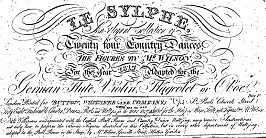 |
Another title in the Le Sylphe series of publications. For a content listing see here.
Full Title: Le Sylphe, an Elegant Collection of Twenty Four Country Dances, the figures by Mr. Wilson, for the year 1817. Adapted for the German Flute, Violin, Flageolet or Oboe.
Image © BRITISH LIBRARY BOARD, a.9.k.(3.) ALL RIGHTS RESERVED
|
Forty Eight Fashionable Country Dances, Reels and Waltzes, for the year 1817
|
|
This document is advertised on the cover of the previous work.
An advert in The New Monthly Magazine offers a review: This book contains much grave matter, food for much serious reflection, "full of wise saws and modern instances." The adsurdity of good old times is displayed in glowing colours and an improved method of waltzing pointed out. From this sample of modern dancing, we are almost tempted, in spite of the rheumatism, to throw aside our flannels, and buy a pair of pumps. At page 9 the author learnedly asserts, that "The waltzes in this collection will be found more useful to the dancer than those published in any other, as they are not only adapted for waltzing, but having proper figures set to them, may be danced as country dances, and likewise for country-dance waltzes, or waltz country-dances!!!" .
Full Title: Forty Eight Fashionable Country Dances, Reels and Waltzes, for the year 1817, Adapted for the Harp or Piano Forte, with Figures by Mr Wilson.
|
The Ecossoise Instructor
1817
|
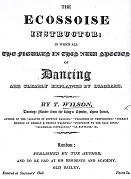
|
La Belle Assemblée reported in 1817 that this work was just published 26. The Ecossoise is a variant of English Country Dancing in which the first couple begin improper (the man on the ladies side of the set). The book contains twelve Ecossoise, with appropriate figures; the whole of the figures explained by diagrams .
Wilson explains: The origin of the Ecossoise was probably derived from France, and imported from thence into Russia, and seems formerly to have been the Contra Dance of that Country; and tho' the term by which this species of Dancing is named is French, with a Scotch definition yet the Dance and the Music properly adapted to it are purely Russian .
He also explains that this dance form is similar to Spanish Contra Dance tho' differing entirely from that Dance both in figures and steps . Wilson sometimes refered to this book as his Ecossaise Instructor and other variant forms also get used. The term Ecossaise referred to a different dance form elsewhere in Europe, Wilson appears to have appropriated an existing term to describe a new dance format he himself introduced.
Wilson went on to speak of this work in his 1824 Danciad: as soon as the "Ecossoise Instructor" was published, though the system was previously unknown, yet another Ecossoise Instructor immediately appeared at half the original price. Such conduct has since obliged the Author to put his name to all his own compositions, however trifling . The competing work was almost certainly that of G.M.S. Chivers. Chivers advertised that he taught Ecossoise dances in 1818 (The Morning Post, 13th November) and he published his own Ecossoise Companion no later than 1819 at just 1s6d (The Observer, 23rd January 1820).
Wilson's instructor cost 5s.
Full Title: The Ecossoise Instructor; in which all the figures in this new species of dancing are clearly explained by diagrams. By T. Wilson, Dancing Master from the King's Theatre, Opera House.
Image © BRITISH LIBRARY BOARD, h.125.(33.) ALL RIGHTS RESERVED
|
A New Circular System of English Country Dancing
1818
|

|
The Gentleman's Magazine reviewed this work in 181827. It was co-authored by both Wilson and his friend Richard Williamson (who was also the engraver for his Quadrille and Cotillion Panorama and The Quadrille Fan).
According to Belle Assemblée28, this work introduces an innovation which enables a whole company to commence a dance at the same time . They go on to say: This admirable invention affords, alike, pleasure and regularity to those who 'thread the mazes of the dance:' from the neutral couple, all confusion is prevented; the tiresome inactivity of several couples standing unemployed, is done away with, and even an unengaged spectator is gratified by the agile movements of so many graceful forms; all animated, as if by the same spirit, and no one breaking off, or leaving the dance (as was formerly too much practised) till the whole is ended. .
This two page document describes a longways country dancing set, bent into a circular formation (with men on the outside). The dancers form into groups, then dance regular country dances. Each group begins dancing at the same time and the dance pauses when the first couples progress back to their original positions, at which point the second couple in each group is given the chance to lead.
Five years later Wilson began to teach his arcular or circular Quadrilles, in 1822. They may be derived from the ideas in this publication. Another dance master, G.M.S. Chivers published his own Chivonian Circle Explained at around the same time.
We've written more about this work in another paper, you might like to follow the link to read more.
Full Title: A New Circular System of English Country Dancing, to which is annexed Thirty Country Dance Figures. By Thomas Wilson, from the King's Theatre, and Richard Williamson.
It cost 1s 6d plain, or 2s coloured.
Image © RSA, London. ALL RIGHTS RESERVED.
|
Le Sylphe, An elegant collection of twenty four country dances for the year 1818
|
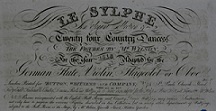
|
This is published in 1818, through Button and Whitaker. For a content listing see here.
Full Title: Le Sylphe, an elegant collection of Twenty Four Country Dances, the figures by Mr. Wilson for the year 1818 adapted for the German Flute, Violin, Flageolet or Oboe.
|
Button, Whitaker and Compy's Twenty Four Country Dances, for the year 1818
|
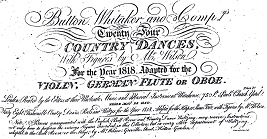 |
Another Wilsonian Country Dance collection published by Button & Whitaker. For a content listing see here.
Full Title: Button, Whitaker and Compy's Twenty Four Country Dances, with figures by Mr. Wilson, for the year 1818. Adapted for the Violin, German Flute or Oboe.
Image © BRITISH LIBRARY BOARD, a.9.k.(4.) ALL RIGHTS RESERVED
|
Forty Eight Fashionable Country Dances, Reels and Waltzes for the year 1818
|
|
This work is advertised on the cover of the 1818 Le Sylphe.
Full Title: Forty Eight Fashionable Country Dances, Reels and Waltzes, for the year 1818, Adapted for the Harp or Piano Forte, with Figures by Mr Wilson.
|
British Amphion Encyclopedia of Music
1818
|
|
It's not clear if this work was ever published, though Wilson advertised it at least three times. In 1814 (The Times, 19th December 1814) he wrote the first volume of the British Amphion, or Dancing-master's Assistant, will shortly appear, the more early publication of which has only been prevented in consequence of the many valuable additions and improvements afforded to the work since the publication of the Prospectus, being certain of extending the number of volumes to at least 12. . In 1816 he wrote the First Volume is on the Eve of being completed 30 and in 1818 In a few days will be published the first volume 31.
It appears that Wilson intended to publish a regular musical Journal, focussing on both Music and Dance. I've no evidence that the first volume ever appeared. I suspect Wilson got distracted by his many other publishing endeavours.
The Monthly Magazine in 1818 reported: In a few days will be published, the first volume of the British Amphion Encyclopedia of Music, adapted to the Ball Room; containing the only extensive collection ever published of English, Welsh, Scotch, Irish, French, Italian, and German country-dances, reels, strathspeys, waltzes, minuets, &c. &c. with a variety of new figures, adapted to each; by Thomas Wilson.
|
The Quadrille and Cotillion Panorama
1819, 1822, 1822, 1839?
|

|
An advert in the Morning Chronicle for 7th April 1819 indicates that the first volume of the first edition is just published and that the second part being now in the press will shortly be published. The second edition (pictured) was published in 1822. The first edition may simply have been titled The Quadrille Panorama , The British Review list it as a new work in 182032. Wilson himself refers to the book as The Quadrille Panorama in his 1821 Essay on Deportment 33.
A French source refers to it as Quadrille (the) and cotillon panorama; or Treatise on quadrille dancing, in two parts and dates it to 181934.
An advert for the second edition in the Morning Post (April 27th 1822) indicates the new content to be nine Designs (being characters drawn from life in practical performance), and a Ground Plan, engraved expressly for this Work, to illustrate the Diagrams and facilitate the performance of the Figures. . The second edition sold for 7s 6d. The third edition was also published in 1822 (The New Times, May 17th 1822).
It's published by R & E Williamson. Some catalogues list a further edition published in 1839 - an abnormally late date for a Wilsonian publication. Copies of what are believed to be the 1819 first edition of this book mention availability of the work in both Paris and New York.
|
Thompson's Twenty Four Country Dances, for the year 1819
|
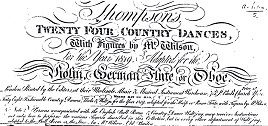 |
This is another Wilsonian Country Dance collection published under the Thompsons insignia. One of the more interesting features is a tune that Wilson adapts to both Country Dancing and Quadrille Dancing. For a content listing see here.
Full Title: Thompson's, Twenty Four Country Dances, with figures by Mr Wilson, for the year 1819. Adapted for the Violin, German Flute or Oboe.
Image © BRITISH LIBRARY BOARD, a.9.aa.(5.) ALL RIGHTS RESERVED
|
Button, Whitaker and Compy's Twenty Four Country Dances, for the year 1819
|
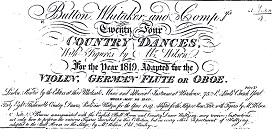 |
For a content listing see here.
Full Title: Button, Whitaker and Compy's Twenty Four Country Dances, with figures by Mr Wilson, for the year 1819. Adapted for the Violin, German Flute or Oboe.
Image © BRITISH LIBRARY BOARD, a.9.aa.(4.) ALL RIGHTS RESERVED
|
L'Assemblée, or Forty-Eight Elegant New Dances for the Year 1819
|
|
The Colonial Music Institute's Dance Figures Index lists this work35, it's also advertised on the cover of the previous work. For a content listing see here.
|
The Complete System of English Country Dancing
1816?, 1818?, 1820, 1826?
|

|
This is a particularly challenging work to date. It's an enhanced version of An Analysis of Country Dancing and was being worked on for much of the 1810s. Wilson announced an intention to publish it in 1814 (The Times, 19th December 1814) along with a work named The English Dancing Master which may have subsequently been combined36. He went on to announce imminent publication in 181637 (with 150 diagrams) and actual publication38. He then announced imminent availability of the work in two volumes in 1818 (The Statesman, 7th March 1818), he also referenced the work as though it already existed within his 1818 New Circular System of English Country Dancing. But he subsequently announced that it was nearly ready for publication in 181939 (with nearly 300 engravings) and that it was nearly complete in January 1820 (National Register, 16th January 1820).
An advert in the Bath Chronicle (November 23rd, 1820) reports This day is published, price 10s 6d in boards, The Complete System of English Country Dancing; containing all the Figures in general use, with a variety of new Figures and Reels, composed expressly by the Author, and elucidated by means of Diagrams; also, scientific Instructions for composing Country Dances; the Etiquette of the Ball-Room; description of the various Times, Measures, and Styles of Country Dance Music, and a Dissertation, comparing the original with the present state of English Country Dancing, Dancing Masters and Dancing Rooms.
It's unclear whether early versions were actually available in either 1816 or 1818, if they were then a further significant update was being planned. One of the dance plates within the edition I have access to is explicitly dated 1820. The Teachers essay refers to several publications by G.M.S. Chivers that weren't published until 1819, including his Recueil de Danses Espagnoles. It also references Chivers' Dancers' Guide as being in the press and that wasn't published until 1821 (or late 1820). If the Complete System was published in either 1816 or 1818 then it wasn't in its final form, Wilson claimed in his 1851 declaration to the Royal Literary Fund that it was published in 1820.
A subsequent advert in 1826 indicates that Complete System had recently been published40, presumably a subsequent edition. It's unclear why An Analysis of Country Dancing was republished in 1822 if the Complete System successor was published in 1820 (and/or 1816/1818).
Regardless of the actual first date of publication, the contents of the book are relevant to the ballrooms of the 1800s and 1810s. The book also contains references to works Wilson intended to publish but are not known to exist. This includes works on Marching, Reeling and A very full Treatise on the Etiquette of Assemblies .
|
Whitaker & Compy's Twenty Four Country Dances for the year 1820
|
|
For a content listing see here.
Full Title: Whitaker and Compys Twenty Four Country Dances, with figures by Mr. Wilson, for the year 1820, adapted for the Violin, German Flute or Oboe.
|
The Quadrille Country Dance Preceptor
1820
|
|
Wilson published several adverts in 1820 announcing that this work was soon to be published, it's unclear whether it was ever in fact published. His advert in The Morning Chronicle (18th January, 1820), indicates The Quadrille Country Dance Preceptor, and the Complete System of English Country Dancing, are now both nearly completed . A similar advert in The National Register (16th January 1820) indicates that the preceptor of Mr. Wilson's newly invented species of dancing entitled Quadrille and Country Dancing, is now nearly complete. A footnote in Thompson's Twenty Four Country Dances for the year 1822 indicates, in reference to Quadrille Country Dancing: This species of Dancing was invented by Mr WILSON by whom the preceptor for the correct performance of these Dances is published .
Many Preceptors were published in London at around this date. The Quadrille was a new and immensely popular dance form, there was a demand for books that taught how to dance them. The preceptors were generally quite small, often just a couple of inches in height and suitable to slip into a reticule. Most included the figures of popular Quadrilles.
|
The Address
1821
|
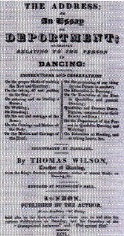
|
We've investigated this work (and provided a full transcript) in another paper, you might like to follow this link to read more.
Wilson first mentioned an essay on deportment in 181436 as part of the proposed content for his Complete System of English Country Dancing. That initial essay is available here.
Wilson subsequently expanded the essay into a full publication that he advertised from 1821. The New Monthly Magazine reviewed the work in mid 182141. This significantly enlarged full version is available through the National Library of Scotland, it provides detailed information for the correct deportment of the social dancer.
Full Title: The Address; or An Essay on Deportment; as chiefly relating to the person in dancing.
|
Thompson's Twenty Four Country Dances for the year 1821
|
|
For a content listing see here.
Full Title: Thompson's Twenty Four Country Dances, with figures by Mr. Wilson, for the year 1821, adapted for the Violin, German Flute or Oboe.
|
The Quadrille Fan
1822
|
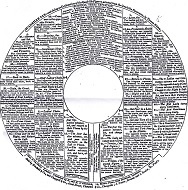
|
This fan was first published in 1822 in support of the Quadrille and Cotillion Panorama. It contained a textual description of the figures used in Quadrille dancing, in a form that could be cut out and formed into (or pasted onto) a hand fan. This might be a valuable accessory to a dancer who's unfamiliar with all of the figures called in Quadrille dancing.
An advert from the Morning Post (January 14th 1822) indicated that the Fan was available for purchase. It reported: New Quadrille Fan, containing Diagrams of all the Quadrille and Cotillion Figures with lines in each figure to follow (correctly drawn from life in practical performance), alphabetically explained in English, with the technical terms; the whole selected and arranged from the Quadrille and Cotillion Panorama, by T Wilson; calculated expressly to refresh the memory as well of the scientific performer as learner. .
A similar Quadrille Fan was published in 1817 by Edward Payne. It's likely that Payne's version inspired Wilson's. James Paine of Almack's also advertised his own Quadrille Fan in 1817 and Louis Litolff published his Quadrille Fan in 1821. We've written more on the general subject of Quadrille fans elsewhere.
Full Title: Quadrille Fan: containing an Explanation of the Quadrille Figures, selected from the Quadrille Panorama, by Thomas Wilson.
Image © BRITISH LIBRARY BOARD, 8705.f.1.(153.) ALL RIGHTS RESERVED
|
Thompson's Twenty Four Country Dances for the year 1822
|
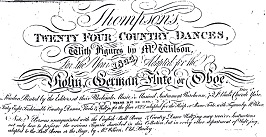 |
For a content listing see here.
Full Title: Thompson's Twenty Four Country Dances, with figures by Mr. Wilson, for the year 1822, adapted for the Violin, German Flute or Oboe.
Image © BRITISH LIBRARY BOARD, a.9.k.(6.) ALL RIGHTS RESERVED
|
Forty Eight Fashionable Country Dances, Reels and Waltzes, for the year 1822
|
|
This document is advertised on the cover of the previous work.
Full Title: Forty Eight Fashionable Country Dances, Reels and Waltzes, for the year 1822, Adapted for the Harp or Piano Forte, with Figures by Mr Wilson.
|
The Complete English Quadrille Preceptor for 1823
|
|
Several catalogues list this work and ascribe it to Thomas Wilson. See, for example, Google42. However, I've not found any clear contemporary evidence that it genuinely was by him, it may be an apocryphal work. It is said to have contained the First Six Almack's Sets, the Lancers, Caledonians, Cuirassiers and Bower Quadrilles. Many of these Quadrilles were also included in Wilson's 1824 Danciad.
The copy at the University of Newcastle is ascribed to An Amateur , which suggests the Wilsonian attribution is dubious.
The preceptor was published by T. Plummer.
|
The Danciad
1820 (Vol 1),
1824 (Vol 2)
|
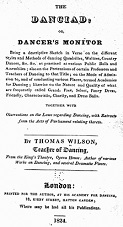
|
This work is an interesting departure from Wilson's more technical publications. It's a review of the state of English dancing, in the form of comic poetry; it's presumably a taste of the style of writing that he would use in his other dramatic works. The New Monthly Magazine reported in 1822 that it was now in the press 43, indicating that it probably had two separate print runs. Wilson claimed in his 1851 declaration to the Royal Literary Fund that the first volume was published in 1820 and the second in 1824. A third volume was advertised to be in great forwardness in the Common Sense newspaper for the 22nd of January 1826, it's unclear whether this thrid volume was ever completed. Part 3 was proposed to contain the remainder of the Article on Quadrilles, and the other Departments of Ball-Room Dancing, with an Epilogue by the Characters .
The Westminster Review contained an extensive review of the Danciad in 182444. Sadly the reviewer had confused our Wilson with a John Wilson, author of various children's poems. This confusion renders most of the biographical information useless! Another review in The London Literary Gazette contrasted Wilson's work with The Tricks of Bakers Unmasked by James Malton45... not the most obvious of comparissons.
Full Title: The Danciad, or Dancer's Monitor. Being a descriptive sketch in verse on the different styles and methods of dancing Quadrilles, Waltzes, Country Dances, &c. &c. as practised at various public balls and assemblies; also on the pretensions of certain professors and teachers of dancing to that title; on the mode of admission to, and of conducting various places, termed academies of dancing; likewise on the nature and quality of what are frequently called Grand, Free, Select, Fancy Dress, Friendly, Characteristic, Charity, and Dress Balls. Together with observations on the laws regarding dancing, with extracts from the acts of parliamenet related thereto. By Thomas Wilson, teacher of dancing, from the King's Theatre, Opera House; author of various works on dancing, and several dramatic pieces.
|
Whitaker & Compy's Twenty Four Country Dances for the year 1824
|
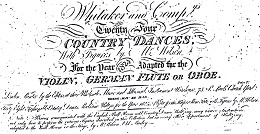 |
This may be the last collection of Country Dances with figures provided by Wilson. For a content listing see here.
Full Title: Whitaker and Compys Twenty Four Country Dances, with figures by Mr. Wilson, for the year 1824, adapted for the Violin, German Flute or Oboe.
Image © BRITISH LIBRARY BOARD, a.9.k.(9.) ALL RIGHTS RESERVED
|
Forty Eight Fashionable Country Dances, Reels and Waltzes, for the year 1824
|
|
This document is advertised on the cover of the previous work. It's not certain that this work existed - the cover of the preceeding work follows a standard template, with a few tweaks each year; one such tweak is the date for the associated Forty Eight &c. work. This work may have remained on the template, without actually existing. The same may have been true for the 1822 edition.
Full Title: Forty Eight Fashionable Country Dances, Reels and Waltzes, for the year 1824, Adapted for the Harp or Piano Forte, with Figures by Mr Wilson.
|
?
1828
|
|
Blackwood's Magazine in December 1827 reported that Wilson was preparing to publish a New Work on Dancing 46. If this unidentified work did get published then it doesn't appear to be any of the other known works.
|
The Art of Dancing
1852
|

|
Several catalogues list this work, see for example Google47.
This work is not written in Wilson's regular writing style and doesn't reference his other works, yet it does use some of his distinctive terminology. It's aimed at beginners and published much later than his other works on dancing.
The contents are listed in the Harvard catalogue48. It contains dances that span several decades including examples from the mid 1840s.
Full Title: The Art of Dancing, comprising its theory and practice, in connexion with the ball room, by which young persons may easily instruct themselves so as to enable them to partake of that healthy, elegant, and polite amusement. By Thomas Wilson, teacher of Dancing.
It cost 8 pence and was printed and published by William Mason.
Image © BRITISH LIBRARY BOARD, 1042.l.39 ALL RIGHTS RESERVED
|
Dramatic Works |
The Disappointed Authoress
1820
|
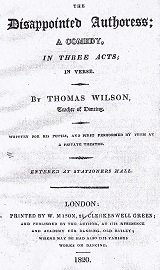
|
Wilson published several dramatic works in the 1820s, including his Danciad. The first was The Disappointed Authoress, a commedy in 3 acts49, costing 2s.
An advert in The Morning Chronicle (November 16th, 1820) reports Mr. Wilson, Teacher of Dancing, as above, respectfully informs his Pupils and their Friends, that his Annual Private Theatricals will take place on Thursday, the 30th inst. The Performance to consist of a new Comedy, in Verse, written by Mr. Wilson, entitled 'The Disappointed Authoress'; together with a new Ballet; the whole to be performed by Mr. Wilson's Pupils - Tickets to be had (gratis) of Mr. Wilson.
I've been lucky enough to read the copy at the National Library of Scotland. A brief essay at the start of the work includes the following message:
The reader is respectfully informed that this dramatic sketch was written merely as an exercise for my pupils, and as a component part of an Entertainment given to them and their friends.
It was composed in verse for the purpose of initiating them in the habit of speaking prologues, epilogues, and other poetical pieces.
Though my engagements with my pupils is to teach Dancing only, yet I have occasionally prepared little dramatic sketches to give a greater scope to their talents, and facilitate the attainment of other accomplishments.
Full Title: The Disappointed Authoress; a comedy in three acts; in verse. By Thomas Wilson, Teacher of Dancing. Written for his pupils, and first performed by them at a private theatre.
Image © National Library of Scotland
|
Plot against Plot
1821
|

|
This is a commedy in 5 acts, costing 4s49. It's also listed amongst Wilson's works in The London Magazine50. A note inside, dated February 1821, explains:
This Comedy, my first dramatic attempt, was written merely for private performance, and acted by my Pupils, in May 1819.
Another Character has been since introduced, and various other additions made; some of the scenes are now therefore marked with single inverted commas, in order that they may be omitted in the performance, if found too long.
Full Title: Plot against Plot. A Comedy. In Five Acts. By Thomas Wilson, Teacher of Dancing. From the King's Theatre, Opera-House. Written for and performed by his Pupils at his Private Theatricals.
Image © National Library of Scotland
|
Double Wedding
1821
|
|
It's listed amongst Wilson's works in The London Magazine50. Wilson's 1851 declaration to the Royal Literary Fund claimed that this work was published in 1821.
An 1821 reviewer in La Belle Assemblee magazine wrote: This piece appears to have been written as the mere vehicle of a variety of dancing, and put into dialogue for pupils. We cannot approve private theatricals for young minds and consider a ballet might have been formed without a comic farce, as this certainly is; but it possesess point and humour, although Captain Martime is not exactly the character of a British commander, and that of Jingleverse is one that is seldom met with. Giles and Bridget, in fact, possess all the genuine humour of the piece, and they are not among the dancers.
|
The Masquerade Rehearsal
1821
|

|
It's listed amongst Wilson's works in The London Magazine50.
A note at the start of this work records: To the reader: An apology appears to be indispensably requisite for the following piece, intitled The Masquerade Rehearsal, which, from want of incident and plot, can scarecely be called dramatic; it was intended merely as a vehicle for display of juvenile talent; as such, it answered its purpose. Since the first performance, some new characters have been added, and its defects, it is hoped, will not be viewed too severely by the liberal critic, who will consider that it has been hastily written, at such unconnected intervals, as could with difficulty be spared from laborious professional pursuits; being obliged, personally to superintend my three academies for dancing, at different parts of the town, and having, consequently, but little leisure to suggest, as some slight counterpoise to its defects, that it passesses one advantage in the facility with which it may be adapted for performance; the variation of adding or omitting a character, can be easily effected, which could not be done in regular dramatic pieces. . This note was dated for November 1821.
Full Title: The Masquerade Rehearsal, A Dramatic Sketch, in three Acts, by Thomas Wilson, (Teacher of Dancing, from the King's Theatre, Opera House). Written for and performed by his pupils, at his private Theatricals.
Image Courtesy of Special Collections at Leeds Libraries
|
The Coronation, a Loyal Effusion
1821
|
|
Wilson's 1851 declaration to the Royal Literary Fund claimed that this work was published in 1821.
An 1821 reviewer in La Belle Assemblee magazine wrote: This poetic effusion has much merit; and this is the species of composition best adapted to display the talents of the youthful performers, and imbue their minds with wholesome sentiments of loyalty. The dramatis personae are the Genius of Britain, Britannia, Hibernia, Caledonia, Cambria, and a British soldier and sailor. At the introduction and dismissal of these characters, appropriate national airs are introduced, and Hibernia's address concludes with the dance of St Patrick's Day. The sailor displays a standard, on which is inscribed our great naval victories; the soldier's banner is inscribed with those of our military, closing with those of our heroic Wellington. The whole terminates with the musical performance of God save the King and Rule Britannia
|
Old Heads upon Young Shoulders
1824
|

|
An advert in The Scots Magazine (1st October 1824) reports 'Old Heads upon Young Shoulders', a Dramatic Sketch in one act. By Thomas Wilson, teacher of dancing, author of the Danciad, &c . It's also listed amongst Wilson's works in The London Magazine50.
A note inside reads: This Piece was first called Sir Toby Formal's Visit to the Ball; it was afterwards performed by children representing old people, and was entitled Old heads upon Young Shoulders . This piece, although first performed in 1822, was not published till August, 1824 . It is further explained inside that it was First performed at Mr. Wilson's Fancy Dress Ball, August 12, 1822 .
Full Title: Old Heads Upon Young Shoulders; or, Sir Toby Formal's Visit to the Ball, A Dramatic Interlude, By Thomas Wilson, Teacher of Dancing (from the King's Theatre, Opera House) Author of various works on Dancing, and several Dramatic Pieces. Price 1s.
Image Courtesy of Special Collections at Leeds Libraries
|
Aquatic Excursion
1824
|
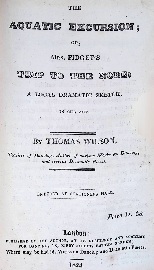
|
An advert in Bibliotheca Cantiana reports the publication of 'The Aquatic Excursion; or, Mrs. Fidget's Trip to the Nore', a local Dramatic Sketch, in one Act, by Thomas Wilson 51. It's also listed amongst Wilson's works in The London Magazine50.
The Nore refers to a sandbank in the Thames Estuary; Wilson advertised in 1825 (The Examiner, 26th June 1825) that he would be organising an Aquatic Excursion to the Nore with tickets costing 7s6d.
A note inside reveals: The local Dramatic Sketch entitled The Aquatic Excursion, (which it will be observed, is more descriptive than dramatic) was written only for the temporary purpose of forming part of the entertainments during an excursion of pleasure to the Nore, in the Venus steam yacht, in September 1824, and was very favourably received by the company, at whose request it is now published; it may perhaps serve the purpose of some who may choose to make use of it on any similar occasion. Since it was performed, additions and alterations have been made in order to adapt it to more general purposes. . This note is dated October 1824.
Full Title: The Aquatic Excursion; or, Mrs. Fidget's Trip to the Nore; a local dramatic sketch, in one act. By Thomas Wilson, Teacher of Dancing, Author of various Works on Dancing, and several Dramatic Pieces. Price 1s6d.
Image Courtesy of Special Collections at Leeds Libraries
|
Songs
1825
|

|
The contents of this work include songs named: The Bill of Fare (As sung in the Dramatic Sketch of The Aquatic Excursion on Wilson's Second Excursion to the Nore, in the Venus, 25th July, 1825 ); Jack Suitable (As sung by Mr. Gibbs in the Dramatic Scene from the Masquerade Rehearsal on Wilson's Second Aquatic Excursion, in the Venus Steam Yacht); Gypsey's Song (as sung in character, by a Young Lady, in the Masquerade given on board the Venus Steam Yacht ); Old Friends with New Faces (As sung in the Masquerade, on Wilson's Second Aquatic Excursion to the Nore ), The Unfortunate Courtship (Sung by Master Richardson, in the Character of Sir Toby Formal, in Old Heads on Young Shoulders , on Wilson's second Excursion to the Nore ); The Ballad Singer (Sung in the Masquerade, on Wilson's second Aquatic Excursion to the Nore ) and Miss Frumps Trip to the Nore (sung by Master Richardson in the Local Sketch entitled the Aquatic Excursion , on Wilson's Second Excursion to the Nore ).
Full Title: Songs, as sung in the various Entertainments given on board the Venus Steam Yacht, in Wilson's Second Excursion to the Nore, Monday, July 25, 1825. By Thomas Wilson, Teacher of Dancing, Author of the Danciad, various Works on Dancing, and Dramatic Pieces. Price 6d.
Image Courtesy of Special Collections at Leeds Libraries
|
The Yule Log
1829
|
|
The London Magazine50 reported that this is a Christmas Eve's Entertainment, after the Ancient Custom, by Thomas Wilson, Teacher of Dancing
|
In the Whole Mouse
1848
|
|
Wilson mentioned this work in his 1851 submission to the Royal Literary Fund. The handwriting in the source document is difficult to read, there may be an error in my transcription of the title.
|
Apocryphal Works (sometimes ascribed to Wilson) |
Analysis of the London Ball-Room
1825
|
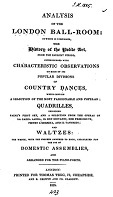
|
This work is often ascribed to Wilson but I think it's very unlikely that he wrote it. Wilson wasn't shy about attaching his name to his works and he used copious cross-references. This work doesn't reference any of his other work, or use his distinctive terminology, so it's unlikely to be by him.
|
Wilson's 1st and 2nd Quadrille Sets
1826, 1827
|

|
An advert in The Morning Post (April 18, 1827) advertised two sets of Quadrilles: The St. James's Quadrilles, or Wilson's 1st Set (second edition) and The Wanstead Quadrilles, or Wilson's 2nd Set . Each set costs 3s 6d.
On further investigation, they're by Mrs. Charles Wilson.
Image © BRITISH LIBRARY BOARD, h.722.xx.(14.) ALL RIGHTS RESERVED
|
The Fashionable Quadrille Preceptor
1830?, 1831
|
|
This work is ascribed to Wilson52 but I've not found any compelling evidence to support this, it's likely to be apocryphal. If it is by Wilson, it's presumably an update to the Quadrille Preceptor for 1823 (though that work in turn is of disputable origin). An advert in the London Age (October 2nd, 1831) indicates that the 6th edition had been published in 1831.
The British Library catalogue entry for the 17th edition of this work credits it to a Professor of Dancing from the King's Theatre but doesn't specifically mention Wilson by name. Wilson doesn't use this phrase elsewhere (he actively ridicules it in The Danciad) but it has been associated with a master called Mr Braunton. It could perhaps refer to G.M.S. Chivers (author of the similarly titled Quadrille Preceptor), to T.W. Lloyd (author of the Royal Quadrille Preceptor), or to the author of the London Quadrille Preceptor.
Sadly, the copy owned by the British Library has been lost. It's not available to be viewed.
|
References
1. The European Magazine, 1811, Literary Intelligence
2. A Treatise on the Art of Dancing, 1810 Chapter 6
3. Google Catalogue The Treasures of Terpsichore for 1810
4. Supplement to the Treasures of Terpsichore, 1816 Contents
5. Third edition of An Analysis of Country Dancing Advert for All the select New Fashionable Dances for 1812
6. British Music Publishers, Printers and Engravers, 1900 Entry for Button & Whitaker
7. Google Catalogue Thompson's Twenty Four Country Dances, for the Year 1813
8. Amazon Catalogue Le Sylphe. An elegant collection of twenty four country dances for the year 1813
9. Amazon Catalogue Le Sylphe. An elegant collection of twenty four country dances for the year 1814
10. British Library Button and Whitaker's twenty four Country Dances, with figures by Mr Wilson. For the year 1814
11. British Library Button and Whitaker and Beadnell's twenty four Country Dances, with figures by Mr Wilson. For the year 1815
12. The Gentleman's Magazine, 1816 Literary Intelligence
13. Google Catalogue The Correct Method of German and French Waltzing ... Second Edition
14. Third edition of An Analysis of Country Dancing Advert for The Ball Room
15. The Gentleman's Magazine, 1816 Review of New Publications
16. The Lierary Gazette, 1817 New Publications
17. New Monthly Magazine, 1817 Review of New Musical Publications
18. The Gentleman's Magazine, 1817 Review of New Publications
19. The Repository of Arts, Literature, Fashions, Manufactures, &c, 1817 Musical Review
20. New Monthly Magazine, 1817 Review of New Musical Publications
21. The Repository of Arts, Literature, Fashions, Manufactures, &c, 1817 New Quadrilles and Waltz Minuet
22. The Repository of Arts, Literature, Fashions, Manufactures, &c, 1817 New Quadrilles and Waltz Minuet
23. La Belle Assemblée, 1817 Varieties Critical, Literary, and Historical
24. The Repository of Arts, Literature, Fashions, Manufactures, &c, 1817 Musical Review
25. The New Monthly Magazine, 1817 Review of New Musical Publications
26. La Belle Assemblée, 1817 Bell's Monthly Compendium of Advertisements for November, 1817
27. The Gentleman's Magazine, 1818 Review of New Publications
28. La Belle Assemblée, 1818 Varieties Critical, Literary, and Historical
29. Amazon Catalogue Button, Whitaker and Compy's Twenty Four Country Dances, with figures by Mr. Wilson, for the year 1818. Adapted for the Violin, German Flute or Oboe
30. A description of the correct method of Waltzing, 1816 Announcement
31. Monthly Magazine, Or, British Register, 1818 Literary and Philosophical Intelligence
32. The British Review, 1820 List of New Books
33. The New Monthly Magazine, 1821 New Publications with Critical Remarks
34. La France litteraire ou dictionnaire bibliographique des savants, 1839 Wilson (Th.)
35. The Colonial Music Institute Bibliography - Wilson L'Assemblee,1819
36. The Monthly Magazine, 1814 New Publications in June
37. The New Monthly Magazine, 1816 Intelligence in Literature and the Arts and Sciences
38. La Belle Assemblée, 1816 Varieties, Critical, Literary, and Historical
39. The Gentleman's Magazine, 1819 Literary Intelligence
40. The Morning Post, 29th December 1826 News
41. The New Monthly Magazine, 1821 Miscellaneous
42. Google Catalogue The Complete English Quadrille Preceptor for 1823
43. The New Monthly Magazine, 1822 Literary Report
44. The Westminster Review, 1824 Professor Wilson's Danciad
45. The London Literary Gazette, 1824 Review of New Books
46. Blackwood's Magazine, 1827 Work's preparing for publication
47. Google Catalogue The Art of Dancing, comprising its theory and practice, in connexion with the ball room
48. Harvard Catalogue The Art of Dancing, comprising its theory and practice, in connexion with the ball room
49. The Scots Magazine, 1821 Monthly list of New Publications
50. The London Magazine, 1829 The Yule Log
51. Bibliotheca Cantiana, 1824 Nore [The]
52. WorldCat The Fashionable Quadrille Preceptor
|

